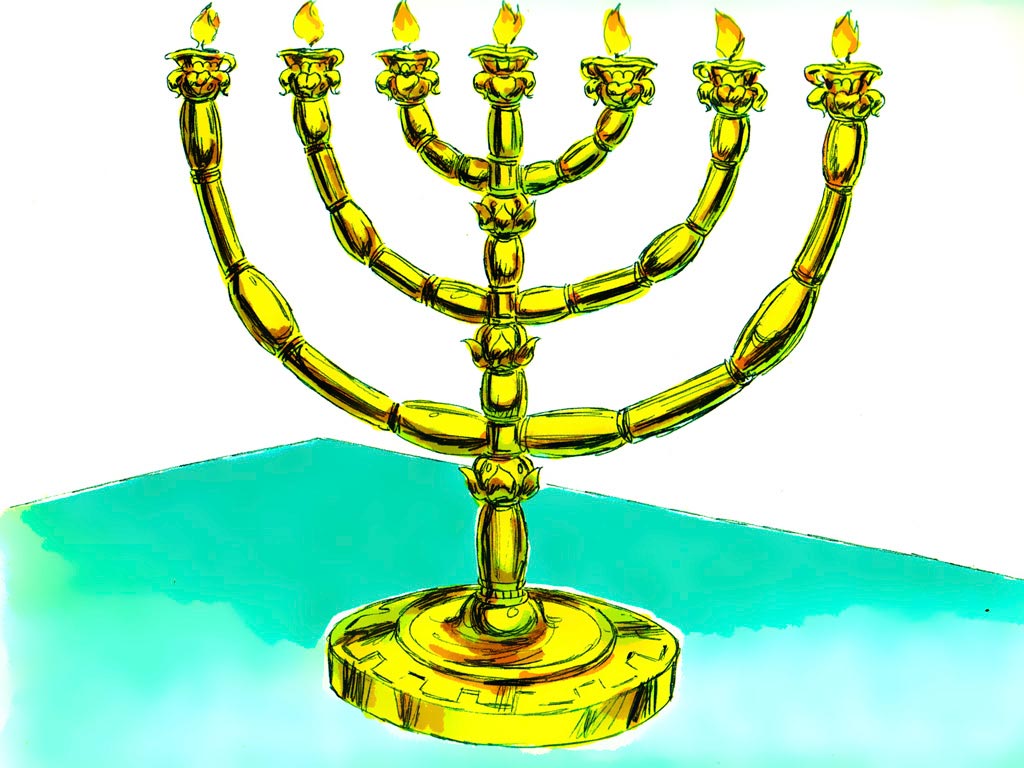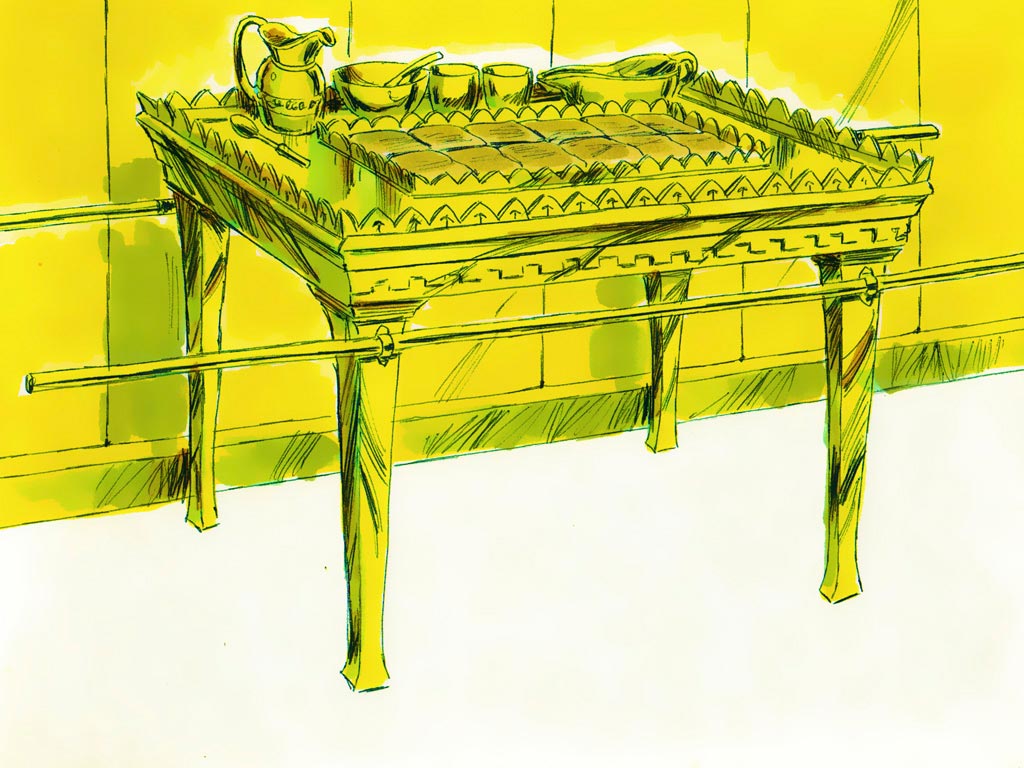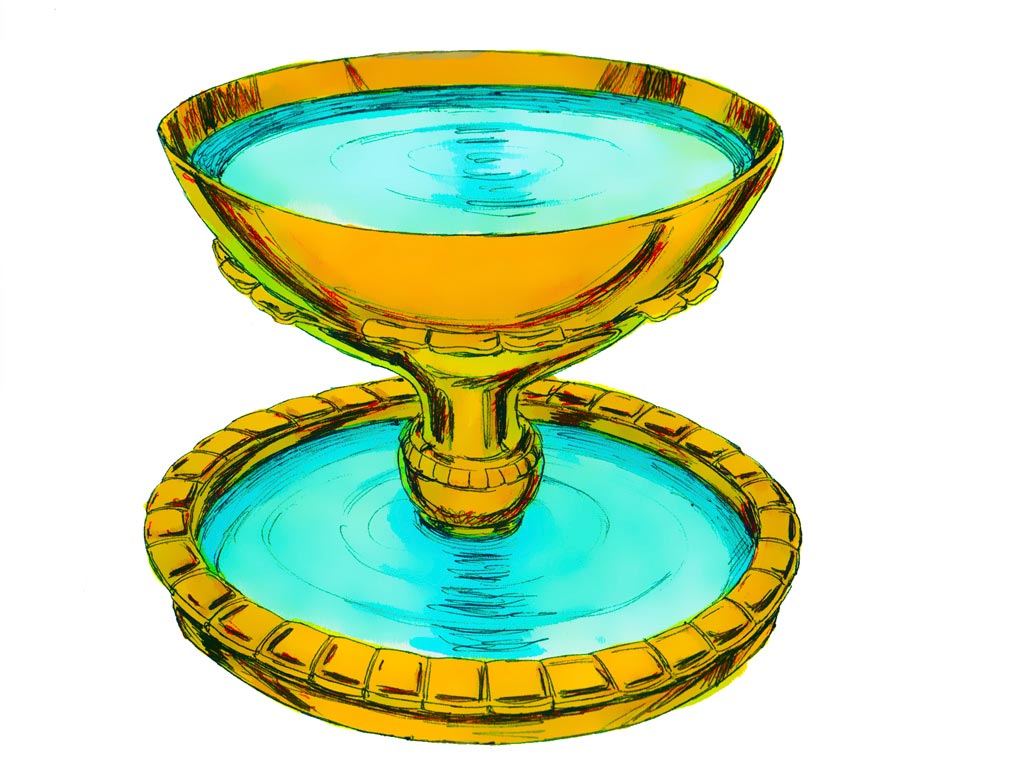 Scripture Reference:
Scripture Reference:![]()
Exodus 35:4 through 40:38
Suggested Emphasis: God wanted to live with His people, and the Israelites gave their possessions, talents and time to make this happen. Practice this same kind of generosity.
Memory Verse: “God will make you rich in every way so that you can always give freely. And your giving through us will cause many to give thanks to God.” 2 Corinthians 9:11, ICB.
Story Overview:
On their journey to the land of promise, God instructed the Israelites to build a tabernacle. This tent structure, its furnishings and even the clothes worn by the priests serving in it were special and beautiful. When asked to give supplies and use their skills to build the tabernacle, the people were so willing and generous that Moses finally had to tell them to stop. When all the work was completed, the presence of God filled the tabernacle and was visible to the people as a cloud by day and a fire by night. When the cloud moved, Israel knew it was time to pack up the Tabernacle along with the rest of their belongings and move to the next stage in their journey.
Background Study:
In the time leading up to the building of the tabernacle, Moses would go outside the camp and meet with God in what he called the “Tent of Meeting.” (Exodus 33:7-11) Now, God was making His presence felt in the middle of the camp. When the people first left Egypt and crossed the Red Sea, they followed a pillar of cloud by day and a pillar of fire by night. In the tabernacle, God would again show His presence in the same way, but this time, it would be in the most holy part of the tent.
It had always been God’s intention that the people would build a tabernacle so that they could worship him in their travels to the land of promise. His presence would be centred in this structure, and the people would have a more tangible way of feeling His presence among them. It was here that the priests would perform their duties. God had given instructions for the tabernacle earlier when He met with Moses on Mount Sinai (Exodus 25:1-31:18), and they are repeated in the Scriptures covered in this lesson.
Unlike many other events on the journey between Egypt and the land of promise, the people seem to throw themselves joyfully into this project. Exodus 35:4-36:7 is filled with language of willingness, and reading the passage is a joy. Moses calls upon the people to give up their possessions and skills to build this special place for God.
The Tabernacle Tent:
Set in the middle of a larger courtyard, the tent of the Tabernacle was divided into two parts, each divided by a curtain.

The first room, called “the Holy Place,” contained the lampstand, the table, and the consecrated bread.
Behind the curtain was the “Most Holy Place”, which contained a golden altar of incense and the ark of the covenant. The priests entered the Holy Place to perform their duties, but only the High Priest ever entered the Most Holy Place, and that was once a year to offer sacrificial blood for the sins of the people. (Leviticus 16:1-34; Hebrews 9:1-14)
 The Ark of the Covenant:
The Ark of the Covenant:
The ark was made of acacia wood and inlaid with gold inside and outside. It contained the gold jar of manna, Aaron’s staff that had budded, and the stone tablets of the covenant. Above the ark were the cherubim of the Glory, overshadowing the atonement cover. (Exodus 37:1-9 and 25:10-22)
 Golden Lampstand:
Golden Lampstand:
The lampstand was made of pure gold and had seven “cups” or places for lights. Olive oil was burned in each of the cups. God instructed Aaron to continually tend the lamps so they would be burning at all times during the day and night. (Exodus 37:17-24; 25:31-40; Leviticus 24:1-4)
Table of the Showbread:
 This table was made of acacia wood and covered with gold. All of the utensils used on the table were also made of gold. Twelve fresh loaves of bread (representing the twelve tribes of Israel) were continually placed on the table as a food offering. Aaron and his sons were allowed to eat this bread as a priest’s share. (Exodus 37:10-16; 25:23-30; Leviticus 24:5-9)
This table was made of acacia wood and covered with gold. All of the utensils used on the table were also made of gold. Twelve fresh loaves of bread (representing the twelve tribes of Israel) were continually placed on the table as a food offering. Aaron and his sons were allowed to eat this bread as a priest’s share. (Exodus 37:10-16; 25:23-30; Leviticus 24:5-9)
Altar of Incense:
 This piece of furniture was also made of wood and overlaid with gold. God gave specific instructions about what kind of spices should be used in the incense. And just like the lights, the incense was to be burned continually. (Exodus 37:25-29 and 30:1-10.34-38)
This piece of furniture was also made of wood and overlaid with gold. God gave specific instructions about what kind of spices should be used in the incense. And just like the lights, the incense was to be burned continually. (Exodus 37:25-29 and 30:1-10.34-38)
 The Brazen Altar:
The Brazen Altar:
This altar was for sacrifices, and it was made of acacia wood and overlaid with bronze. The grating and all of the utensils used in sacrifices were also made of bronze. Like the other larger pieces of furniture in the tent, rings in each corner made it possible for large poles to be slipped through for lifting. This made it easier to transport the altar when the tent was moved. (Exodus 38:1-7 and 27:1-8)
 Basin for Washing:
Basin for Washing:
This basin and stand were placed between the tent and the altar. Made of bronze, it served as a place for Aaron and his sons to wash and purify themselves upon entering the Tabernacle. They were also to wash their hands and feet when offering food. (Exodus 38:8 and 30:17-21)
 Priestly Garments, Ephod, Breastplate:
Priestly Garments, Ephod, Breastplate:
Aaron and his sons were chosen as the first priests, and all subsequent priests were required to be from their tribe, Levi. God instructed Moses to have holy garments made for the priests. Aaron was the first high priest, and God told Moses that the clothing would give Aaron “dignity and honour.” However, it is not clear exactly how the breastpiece that Aaron wore was used in making decisions. It was covered in stones that represented the twelve tribes. (Exodus 39:1-31 and 28:1-43)
Once the building of all the parts was complete, everything was assembled and placed in the appropriate places according to God’s specific instructions. The time had come for God to “dwell” in the tabernacle. In the ongoing journey to the promised land, the Israelites would look to the tabernacle and know God was with them. When the cloud moved, the tabernacle tent would be packed up, and the entire camp would move on to where the cloud settled.
“Then the cloud covered the tent of meeting, and the glory of the Lord filled the tabernacle. Moses could not enter the tent of meeting because the cloud had settled on it, and the glory of the Lord filled the tabernacle.
In all the travels of the Israelites, whenever the cloud lifted from above the tabernacle, they would set out; but if the cloud did not lift, they did not set out—until the day it lifted. So the cloud of the Lord was over the tabernacle by day, and fire was in the cloud by night, in the sight of all the Israelites during all their travels.” Exodus 40:34-38, ICB
Way to Introduce the Story:
“How do we give to God?” Let the children discuss giving money in the collection bags (or plates) on a Sunday morning, helping to clean the church building, bringing food for the needy, etc. Children (and adults) often forget that we can do volunteer work—with no wages—for God’s people. You might want to find out what some people in your congregation do to serve God. Leading the discussion back to the Sunday collection… “Has anyone ever seen the collection container really full? What would you think if people filled the bags (or plates) with money? What if the bags ran over? What if they had to empty the bags and start over? What if people gave so much money that the elders at church had to tell them to stop because there was too much? Did you know that something like that happened in the book of Exodus?”
top
The Story:
After God’s people left Egypt, they walked in the desert for a long time. They would only stay for a while in one place and then move to another. They did not have houses because they had to travel toward their new land.
All the people had tents, but the Lord wanted to build a special tent. This tent would be very beautiful. It would be made of rich cloth and contain furniture inside made of gold. It would be put in the middle of the camp where everyone could see it. Do you know why this tent would be so special? Because this tent was to be the Lord’s tent! It would be called a tabernacle. The word tabernacle means “tent” or “dwelling place.”
Of course, the Lord can live and be anywhere He wants at any time, but He chose to make the tabernacle His home and special place so that the people would think of Him every day. While the Israelites were on their journey through the desert, they would know that God was in the tabernacle when they saw a cloud in the tabernacle tent. In the day, God’s presence would be seen as a cloud; at night, it would be seen as a fire. When the cloud or fire moved to a new place, the people could pack up the tabernacle tent and furniture and move them to the new place.
The Lord said that Moses’ and Aaron’s family or tribe were to take care of the tabernacle. They were descendants of Jacob’s son, Levi. Sometimes, they were called Levites. Only Levites could work in the tabernacle. Some of the workers would be called priests. The priests would help take care of the tabernacle and help the people worship the Lord. They would always wear special clothes inside. God chose Aaron to be the head priest or the High Priest. His sons would help him.
While Moses was on Mount Sinai, God instructed him to build the tabernacle. The materials were to be gathered, and then the tabernacle and the furniture would be made. God gave very specific instructions to Moses. The tabernacle and furniture were to follow God’s pattern exactly.
- The Tabernacle Tent was divided into two parts. The first part was called the “Holy Place”; only priests could enter. The other part was called the “Most Holy Place”, and this is where God would live. Only the High Priest could go to the Most Holy Place and only once each year.
- The Ark of the Covenant was the most important furniture in the tabernacle. It was a wooden box covered on the inside and out with gold. Connected to the top of the ark were statues of two winged creatures, called cherubim, facing each other. The two stone tablets of the Ten Commandments were kept inside, as well as some manna to remember how God took care of His people.
- Golden Lampstand: The lampstand was pure gold, and the seven lights burned with olive oil.
- Table of the Showbread: A table made of acacia wood and covered with gold was made so twelve loaves of bread could always be set on it. Aaron and the other priests were allowed to eat this bread.
- The tabernacle was where God “lived”, so everything about it was special. It even smelled good. There was even an Altar of Incense so that incense could be burned all the time. This altar was made from wood and also overlaid with gold.
- Another altar was called the Brazen Altar, and it was very big. This altar was made from wood but was covered all over with bronze. This was the place where animal sacrifices were made.
- Because the tabernacle was where God lived, everything about it was pure. There was a beautiful bronze Basin for Washing that the priests used for washing themselves.
- Priestly Garments: When the priests performed their duties in the tabernacle, they wore special clothes. Aaron, the High Priest, even wore a special breastplate. This breastplate had beautiful stones on it.
A lot of things were needed to build the tabernacle! Cloth, jewels, gold, special wood, animal skins, and all sorts of rich items would be needed. People with special talents must work hard to build the tabernacle. The Lord did not want the people to buy the things for the tabernacle. He wanted them to give all of the items. God wanted the people to show their love for Him by giving their own things. He also wanted the people to work for free in building the tabernacle. Even if they did not have anything to give, they could still help with the work.
Moses told the people what God had asked them to do: to give offerings willingly—from the heart—to make the tabernacle. Where would the material come from? God’s people were in a desert area far from shops or people to trade with. There was no place where they could buy these supplies. They only had what they had been able to pack hurriedly when they left Egypt. They had some clothing and silver and gold articles that the Egyptians had given them just before they left.
As the Israelites remembered what God had done for them, they wanted to show gratitude. One by one, they began bringing their offerings to the Lord. As the materials arrived, Moses instructed the workers to begin. All kinds of craftsmen were needed: those who could work with wood and metal, those who could design and work with gems, those who could sew and weave and embroider, and those who could spin and make cloth. Lots of people volunteered to help.
Then something unusual happened! The people brought more and more things. The people were bringing so many offerings that they had to be asked to stop! The workmen had all they needed to finish the job God had given them. The work was completed in a little over five months. They had followed God’s instructions, and a beautiful tabernacle was ready for worship.
When he saw that everything was just like God had commanded, Moses and his helpers set up the tabernacle in the middle of the camp. The priests began their work. The giant pillar of cloud and fire that the Israelites had followed since they left Egypt moved and settled on the tabernacle. God was now in His new home!
top
Ways to Tell the Story:
This story can be told using a variety of methods. Always remain true to the facts found in the Bible but help children connect to its meaning by using drama, visual aids, voice inflection or other group participation.
Click here for visual aids and story-telling methods.
Click here to download these illustrations and slideshow. Be selective. Each teacher is unique, so only use the illustrations that best relate to how YOU tell the story in THIS lesson. Too many illustrations can be confusing, so eliminate any that cover other stories or details you do not wish to emphasise in this lesson.
Review and Reflection Questions:
Review questions help children remember and know the facts of a story, while reflection questions encourage them to internalize its meaning and implications for their lives. Asking at least one of each type of question can help strengthen a child’s spiritual development and help them connect to God. Click here to learn more about review and reflection questions.
Review:
- What was God’s special tent called? (the tabernacle)
- What tribe served as priests in the tabernacle? (The tribe of Levi called the Levites)
- What was the tabernacle for? (It was God’s home, and where the priests would worship God by bringing Him sacrifices)
- Who was the first High Priest? (Aaron)
- How did the Israelites know that God lived in the tabernacle? (The pillar of cloud filled the tabernacle. When it was time for the people to move to a different part of the desert, the pillar would remove itself from the tabernacle)
Reflection:
- How do you think the people felt when Moses asked them to give away their possessions for the tabernacle?
- How do you think God felt when the tabernacle was completed and when He first lived in it?
- Can you imagine the tabernacle? How big do you think it was?
- What do you think God enjoyed about the tabernacle?
- What is something you wonder about in this story?
Prayer:
It is important to guide children in learning how to pray. In prayer, children can connect with God and learn that He hears and answers them. God can become a life-long friend who is with them every moment of their lives. Try using a variety of prayer methods from time to time so that the children can learn to connect with God in different ways. Note that you can pray at any time throughout your lesson. A variety of prayer methods are found here.
Song Suggestions:
- Love is Something If You Give It Away Song
- Sing songs from the church songbook concerning giving.
- Refer to the Song Page on this website for more options.
Activities and Crafts:
(How to choose the best learning activities for my teaching situation)
Activities:
- Use commentaries or bible dictionaries to look up drawings of the Tabernacle and all of its furnishings. Also, see what the priests wore.
- Make a tent.
- Older children can draw comparisons between Old and New Testament worship.
- Use a concordance and look up scriptures concerning giving to the Lord.
 The tabernacle was a beautiful place built to represent the holiness of his presence. Create a “special and holy” place in the room where you are teaching where children can pray and talk about how holy and special God is.
The tabernacle was a beautiful place built to represent the holiness of his presence. Create a “special and holy” place in the room where you are teaching where children can pray and talk about how holy and special God is.- To help children better understand the concept of generosity in everyday life situations, try using this simple conversation starter: “Things Matter.”
 Invite the children to respond to this story using the adaptable “God’s Story” printable reflection page. Free printables for this story.
Invite the children to respond to this story using the adaptable “God’s Story” printable reflection page. Free printables for this story.
Crafts:
- Colour a picture of the Tabernacle. Use gold paint or glitter on the appropriate furnishings.
- Older children might make a replica model of the Tabernacle or any furnishings.
 Print bookmarks, trading cards or timelines (printable pages).
Print bookmarks, trading cards or timelines (printable pages).- Visit the Teaching Ideas page for additional activities and crafts.
Other Online Resources:
- Colouring page The tabernacle & puzzle worksheets (Calvary Curriculum)
- Game: ‘Journey to the Promised Land’ (Christian Crafters)
- Other: Ideas for teaching about money to older children (Ministry to Children)
- Other: Silly song about The Tabernacle (Philip Jenkins)
- Other: Video: “3D Tabernacle of Moses” by Messages of Christ. Youtube video 1 minute and 52 seconds.
- Other: Video: “The Tabernacle and the Messiah” by Messages of Christ. The Youtube video is just over 10 minutes long). Very good background information that explains the connection between the Tabernacle and the future Messiah.
- Other: 3D Video: Amazing views of the Tabernacle by Jeremy Park at Bible Scenes
https://nz.pinterest.com/marynnz/moses-wilderness-wanderings/
 ©Mission Bible Class 2011-2025. Before copying or reproducing any portion of this website, please carefully read the “Copyrights and Permissions Page.” https://missionbibleclass.org/about/copyrights-and-permissions/ (Not to be sold or profited from in any way.) www.missionbibleclass.org
©Mission Bible Class 2011-2025. Before copying or reproducing any portion of this website, please carefully read the “Copyrights and Permissions Page.” https://missionbibleclass.org/about/copyrights-and-permissions/ (Not to be sold or profited from in any way.) www.missionbibleclass.org









